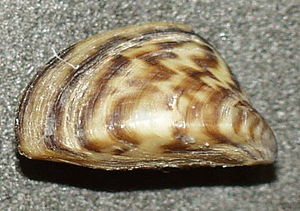Triangular clams
| Triangular clams | ||||||||||||
|---|---|---|---|---|---|---|---|---|---|---|---|---|

Wandering mussel ( Dreissena polymorpha ) |
||||||||||||
| Systematics | ||||||||||||
|
||||||||||||
| Scientific name | ||||||||||||
| Dreissenidae | ||||||||||||
| JE Gray , 1840 |
The triangular clams (Dreissenidae) are a family of clams from the order of the Myida . It is the only family in the Dreissenoidea superfamily.
features
The housings are fingernail up to approx. 5 cm in size. They are mussel-shaped ( mytiliform ), horseshoe-shaped ( modioliform ) or rounded triangular. The vertebra (umbo) is marginal or is very close to the edge. An umbonal septum is present but can be rudimentary. The lock is toothless and the sphincters are of unequal size (heteromyar) with the anterior sphincter attached to the septum. The gills belong to the owl lamella branched type. The bowl is made of aragonite . In cross-section, it consists of an inner layer of complex cross lamellas and an outer layer of simple lamellas and cross lamellas. The larvae are free-swimming; the adults, like the mussels, attach themselves to the ground with byssus threads .
distribution
Since the Ypresium stage of the Eocene , representatives of the family can be found in Europe and Asia Minor, in the east as far as Kazakhstan ( Aral Sea ). From the late Oligocene onwards , they also occur in Central and tropical South America, from where they spread to North America during the Neogene .
Species are introduced in India, Hong Kong and Japan, presumably also in the Fiji Islands and in West Africa. The species Mytilopsis leucophaeata , originally from North America, occurs today in the Kiel Canal , among other places, but also in the Black Sea, where it displaces other types of mussels. The migrating mussel ( Dreissena polymorpha ) and the quagga three-sided mussel ( Dreissena rostriformis bugensis ) originally come from the Ponto-Caspian region and occur as neozoa in Europe and North America.
Congeria are key fossils of the Pannon , whose deposits are known from the tectonic subsidence area between the Alps and the Carpathian Mountains .
Systematics
Molecular genetic studies showed that the triangular clams are the sister taxon of a clade from the Myidae and the Corbulidae ; the Pholadidae and the shipworms are further related . In the latest classification they are therefore placed in the order Myida.
The family comprises two subfamilies, one of which (Dreisseninae) includes the three recent genera, the Dreissenomyinae two genera known only from fossils (selection of species):
- Dreisseninae subfamily
-
Dreissena
- Dreissena polymorpha , the migrating mussel
-
Dreissena rostriformis
- Dreissena rostriformis rostriformis
- Dreissena rostriformis bugensis , the quagga triangular clam
- Dreissena presbensis
- Dreissena blanci
- Dreissena caspia
- Dreissena elata
- Congeria
-
Mytilopsis
- Mytilopsis leucophaeata , the brackish triangular clam
-
Dreissena
- Subfamily Dreissenomyinae
A first molecular genetic investigation of the internal systematics of the recent genera indicated that Congeria and Mytilopsis are sister taxa and form a clade that is opposite to Dreissena .
literature
- Mathias Harzhauser, Oleg Mandic: The muddy bottom of Lake Pannon - a challenge for dreissenid settlement (Late Miocene; Bivalvia) , In: Palaeogeography, Palaeoclimatology, Palaeoecology 204, 2004, pp. 331–352, PDF Online
Individual evidence
- ↑ a b c Rüdiger Bieler, Paula M. Mikkelsen, Timothy M. Collins, Emily A. Glover, Vanessa L. González, Daniel L. Graf, Elizabeth M. Harper, John Healy, Gisele Y. Kawauchi, Prashant P. Sharma, Sid Staubach, Ellen E. Strong, John D. Taylor, Ilya Tëmkin, John D. Zardus, Stephanie Clark, Alejandra Guzmán, Erin McIntyre, Paul Sharp, Gonzalo Giribet: Investigating the Bivalve Tree of Life - an exemplar-based approach combining molecular and novel morphological characters. Invertebrate Systematics, 28: 32–115, 2014 doi : 10.1071 / IS13010
- ↑ a b c C. P. Nuttall: Review of the Caenozoic heterodont bivalve superfamily Dreissenacea In: Palaeontology, 33: 3, 1990, pp. 707-737
- ↑ Yasuo Kondo and Shin-ichi Sano: Origination of extant heteroconch families: Ecological and environmental patterns in post-Paleozoic bivalve diversification. Palaeontological Research, 13: 39-44, Tokyo 2009 doi : 10.2517 / 1342-8144-13.1.039
- ^ V. Wiese: "Atlas of the land and fresh water mollusks in Schleswig-Holstein", 1991, p. 210, online (as Congeria leucophaeata (Conrad 1831)
- ↑ a b Thomas W. Therriault, Margaret F. Docker, Marina I. Orlova, Daniel D. Heath, Hugh J. MacIsaac: Molecular resolution of the family Dreissenidae (Mollusca: Bivalvia) with emphasis on Ponto-Caspian species, including first report of Mytilopsis leucophaeata in the Black Sea basin In: Molecular Phylogenetics and Evolution 30, 2004, pp. 479-489
- ↑ Zdravko Hubenov: Dreissena (Bivalvia: Dreissenidae) - systematics, autochthonous and anthropogenic areas. Acta zoologica bulgarica, 57 (3), pp. 259-268, 2005
- ↑ MolluscaBase: Dreissenidae Gray, 1840
- ^ CP Nuttall: Review of the Caenozoic heterodont bivalve superfamily Dreissenacea In: Palaeontology, 33: 3, 1990, pp. 707-737